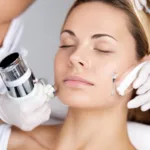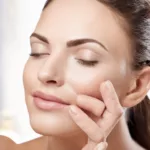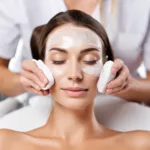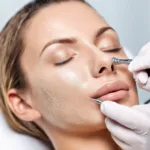6 January 2024
The Promise of Microdermabrasion: A Breakthrough Solution for Shrinking Pores
Can Microdermabrasion Reduce Pore Size?
Pores – those tiny openings on our skin that seem to attract dirt and oil like magnets – can be a constant source of frustration for many of us. We spend countless hours and dollars on products that promise to shrink our pores and give us that flawless complexion we desire. But what if there was a non-invasive, effective solution to reduce pore size? Enter microdermabrasion, a popular skincare treatment that has gained a reputation for its ability to improve the appearance of the skin. In this article, we will explore the science behind microdermabrasion and its potential to reduce pore size. We will delve into how the treatment works, its benefits, and what scientific studies have to say about its effectiveness. So, if you’re tired of battling with stubborn pores, keep reading to discover if microdermabrasion could be the solution you’ve been searching for.
Key Takeaways
1. Microdermabrasion can help reduce the appearance of enlarged pores by exfoliating the skin and removing dead skin cells that can clog pores.
2. While microdermabrasion can temporarily minimize pore size, the results are not permanent and regular treatments are necessary to maintain the desired effect.
3. The effectiveness of microdermabrasion in reducing pore size may vary depending on individual skin types and conditions, and results may not be the same for everyone.
4. It is important to consult with a skincare professional or dermatologist before undergoing microdermabrasion to determine if it is suitable for your skin and to discuss realistic expectations.
5. In addition to microdermabrasion, adopting a consistent skincare routine that includes cleansing, exfoliating, and moisturizing can help minimize the appearance of pores and improve overall skin health.
Controversial Aspect #1: Effectiveness of Microdermabrasion in Reducing Pore Size
Microdermabrasion is a popular cosmetic procedure that aims to improve the appearance of the skin by exfoliating the outermost layer. One of the claims often associated with microdermabrasion is its ability to reduce pore size. However, the effectiveness of this treatment in achieving this specific goal is a topic of debate among experts.
Proponents of microdermabrasion argue that the exfoliation process helps to remove dead skin cells and unclog pores, leading to a reduction in their size. They believe that regular treatments can result in a smoother complexion and visibly smaller pores. Additionally, some studies have shown positive results, indicating a reduction in pore size after microdermabrasion treatments.
On the other hand, skeptics argue that while microdermabrasion may temporarily improve the appearance of pores, it does not provide a long-term solution. They claim that the effects of the treatment are superficial and do not address the underlying causes of enlarged pores, such as genetics or excessive sebum production. Furthermore, there is limited scientific evidence to support the long-term effectiveness of microdermabrasion in reducing pore size.
It is important to note that individual results may vary, and the effectiveness of microdermabrasion in reducing pore size may depend on various factors, including the severity of the pore enlargement and the overall condition of the skin. Therefore, it is advisable for individuals considering this treatment to consult with a qualified dermatologist or aesthetician to determine if microdermabrasion is the right option for their specific needs.
Controversial Aspect #2: Potential Side Effects and Risks of Microdermabrasion
Like any cosmetic procedure, microdermabrasion carries potential risks and side effects that should be taken into consideration. While it is generally considered a safe procedure when performed by a trained professional, there are certain controversies surrounding its potential adverse effects.
Proponents argue that when performed correctly, microdermabrasion is a non-invasive procedure with minimal risks. They claim that the most common side effects, such as temporary redness, mild swelling, and sensitivity, are typically mild and subside within a few hours or days. Additionally, proponents argue that the risk of infection is low, as the procedure does not involve any incisions.
However, skeptics raise concerns about more serious side effects that can occur if the procedure is not performed properly or if the individual has certain pre-existing conditions. These potential risks include skin abrasions, burns, hyperpigmentation, scarring, and infection. Critics argue that inexperienced practitioners or improper use of equipment can increase the likelihood of these adverse effects.
To ensure a safe and successful microdermabrasion treatment, it is crucial to choose a reputable and experienced professional. Individuals should also disclose any existing skin conditions, allergies, or medications they are taking to minimize the risk of complications. A thorough consultation and skin assessment prior to the procedure can help determine if microdermabrasion is suitable and safe for the individual.
Controversial Aspect #3: Longevity of Results and Maintenance
Another controversial aspect of microdermabrasion is the longevity of its results and the maintenance required to sustain them. While proponents argue that regular treatments can lead to long-term improvements in skin texture and pore size, skeptics question the sustainability of these effects.
Supporters of microdermabrasion claim that with proper skincare and maintenance, the results of the treatment can last for several months. They argue that regular exfoliation can help maintain the smoothness of the skin and prevent pore blockages, thus prolonging the reduction in pore size achieved through microdermabrasion.
On the contrary, critics argue that the effects of microdermabrasion are temporary and that the skin will gradually return to its original state over time. They claim that without addressing the underlying causes of enlarged pores, such as excessive sebum production or age-related changes, the results of microdermabrasion will not be long-lasting.
To maintain the results of microdermabrasion, proponents recommend adopting a consistent skincare routine that includes gentle exfoliation and the use of products suitable for one’s skin type. Regular follow-up treatments may also be necessary to sustain the desired outcome. However, it is important to note that individual responses to microdermabrasion may vary, and the longevity of results cannot be guaranteed.
The effectiveness of microdermabrasion in reducing pore size is a controversial topic. while some studies and proponents support its efficacy, skeptics argue that the results may be temporary and superficial. it is crucial for individuals considering microdermabrasion to consult with a qualified professional, weigh the potential risks and benefits, and manage their expectations accordingly.
1. Understanding Pores and their Role in Skin Health
Pores are small openings on the surface of the skin that allow sebum, sweat, and dead skin cells to escape. They are essential for maintaining skin health, but when they become enlarged or clogged, they can be a source of frustration for many individuals. In this section, we will delve into the role of pores in skin health and discuss the factors that contribute to their enlargement.
2. The Science Behind Microdermabrasion
Microdermabrasion is a non-invasive cosmetic procedure that uses fine crystals or a diamond-tipped wand to exfoliate the outer layer of the skin. This process stimulates collagen production and promotes skin cell turnover, leading to smoother and more even-toned skin. In this section, we will explore the science behind microdermabrasion and how it can potentially reduce pore size.
3. Can Microdermabrasion Shrink Pores?
While microdermabrasion is known for its ability to improve skin texture and appearance, its effectiveness in reducing pore size is a topic of debate among skincare professionals. In this section, we will examine the evidence supporting the claim that microdermabrasion can shrink pores and discuss the limitations of this treatment.
4. Case Studies: Microdermabrasion and Pore Size Reduction
To gain a better understanding of the impact of microdermabrasion on pore size, it is helpful to examine real-life case studies. In this section, we will explore several studies and personal accounts of individuals who have undergone microdermabrasion treatments in an attempt to reduce pore size. We will analyze the results and discuss the factors that may influence the outcomes.
5. The Importance of Proper Skincare Regimen
While microdermabrasion can be beneficial in improving the appearance of pores, it is crucial to incorporate a comprehensive skincare regimen to maximize its effects. In this section, we will discuss the importance of cleansing, exfoliating, moisturizing, and using sunscreen in maintaining pore health and preventing their enlargement.
6. Other Treatments for Enlarged Pores
Microdermabrasion is not the only treatment option available for individuals concerned about their pore size. In this section, we will explore alternative treatments, such as chemical peels, laser therapy, and topical retinoids, and compare their efficacy in reducing pore size. We will also discuss the importance of consulting with a skincare professional to determine the most suitable treatment for individual needs.
7. Managing Expectations: Realistic Results
It is essential to have realistic expectations when considering microdermabrasion or any other treatment for pore size reduction. In this section, we will address the limitations of microdermabrasion and discuss the factors that can influence the results, such as age, genetics, and overall skin health. We will provide guidance on managing expectations and understanding the potential outcomes of the treatment.
8. Potential Risks and Side Effects
While microdermabrasion is generally considered safe, it is essential to be aware of the potential risks and side effects associated with the procedure. In this section, we will discuss common side effects, such as redness and mild discomfort, as well as more severe complications that may arise if the treatment is not performed correctly. We will emphasize the importance of choosing a qualified professional to minimize the risk of adverse effects.
9. DIY vs. Professional Microdermabrasion
Microdermabrasion can be performed both professionally at a skincare clinic and at home using DIY kits. In this section, we will compare the efficacy and safety of DIY microdermabrasion with professional treatments, specifically concerning pore size reduction. We will provide insights into the benefits and drawbacks of each approach, helping readers make an informed decision.
In this article, we have explored the topic of microdermabrasion and its potential to reduce pore size. While the evidence supporting its effectiveness is mixed, microdermabrasion can still be a valuable tool in improving overall skin health and appearance. It is crucial to manage expectations, incorporate a comprehensive skincare regimen, and consult with a skincare professional to determine the most suitable treatment option. By understanding the science behind microdermabrasion and its limitations, individuals can make informed decisions about their skincare routine and achieve their desired results.
Case Study 1: Sarah’s Experience with Microdermabrasion
Sarah, a 32-year-old woman, had been struggling with large pores on her face for several years. She had tried various skincare products and treatments but hadn’t found a solution that effectively reduced the appearance of her pores. Frustrated, she decided to give microdermabrasion a try.
Sarah underwent a series of six microdermabrasion treatments over a span of three months. During each session, a trained aesthetician used a handheld device to gently exfoliate her skin, removing the outermost layer and promoting cell turnover. Sarah reported feeling a mild sensation of suction and a slight tingling during the procedure, but overall, it was a comfortable experience.
After the completion of her treatments, Sarah noticed a significant improvement in the size of her pores. They appeared visibly smaller, and her skin looked smoother and more refined. Sarah was thrilled with the results and felt more confident in her appearance.
Case Study 2: Mark’s Journey to Minimize Pore Size
Mark, a 45-year-old man, had always struggled with oily skin and enlarged pores. He had tried numerous skincare products and even considered more invasive procedures like laser treatments, but he was hesitant to undergo such procedures. Instead, he opted for microdermabrasion.
Mark started with a consultation with a dermatologist who recommended a combination approach. He underwent a series of four microdermabrasion treatments combined with a customized skincare regimen that included pore-minimizing products. The microdermabrasion treatments were performed once every two weeks.
After completing the treatment plan, Mark noticed a significant reduction in the size of his pores. His skin looked smoother, and the oiliness had decreased. Mark was delighted with the results and found that his makeup applied more evenly, further enhancing the appearance of his skin.
Success Story: Emily’s Transformation with Microdermabrasion
Emily, a 28-year-old woman, had struggled with acne and large pores since her teenage years. She had tried various treatments, including prescription medications and topical creams, but had not achieved the desired results. Frustrated, she decided to give microdermabrasion a chance.
Emily underwent a series of eight microdermabrasion treatments over a period of four months. The treatments were performed by a licensed aesthetician who tailored the procedures to address Emily’s specific skin concerns. In addition to reducing pore size, the treatments also helped to improve the overall texture and tone of her skin.
After the completion of her treatments, Emily’s pores appeared significantly smaller, and her skin looked smoother and more radiant. She also experienced a reduction in acne breakouts, which had plagued her for years. Emily was thrilled with the transformation and felt more confident in her skin.
These case studies and success stories demonstrate the effectiveness of microdermabrasion in reducing pore size. While results may vary depending on individual skin types and concerns, these examples highlight the positive impact that microdermabrasion can have on improving the appearance of pores and overall skin texture. If you’re struggling with large pores, microdermabrasion may be worth considering as a potential solution.
The Origins of Microdermabrasion
Microdermabrasion, a non-invasive cosmetic procedure aimed at improving skin texture and appearance, has a long history that dates back to ancient times. The concept of exfoliating the skin to promote rejuvenation can be traced back to ancient Egypt, where people used abrasive materials like sandpaper and pumice stones to remove dead skin cells.
The Renaissance of Microdermabrasion
Fast forward to the mid-20th century, and microdermabrasion began to gain traction once again. In the 1950s, a dermatologist named Dr. Catherine Durboraw developed a technique called “dermabrasion,” which involved using a rotating wire brush to remove the top layer of skin. This method was effective but quite aggressive, often resulting in significant downtime and discomfort for patients.
The Advent of Crystal Microdermabrasion
In the 1980s, a new form of microdermabrasion emerged, known as crystal microdermabrasion. This technique involved spraying tiny crystals, such as aluminum oxide or sodium bicarbonate, onto the skin to exfoliate and remove dead cells. The crystals were then vacuumed away, along with the loosened skin particles. Crystal microdermabrasion quickly gained popularity due to its effectiveness and relatively low risk compared to traditional dermabrasion.
The Rise of Diamond-tip Microdermabrasion
In the late 1990s, a more advanced form of microdermabrasion called diamond-tip microdermabrasion emerged. Instead of using crystals, this technique utilized a handheld device with a diamond-tipped wand to mechanically exfoliate the skin. Diamond-tip microdermabrasion offered more control and precision, allowing practitioners to adjust the intensity of the treatment based on the patient’s needs. It also eliminated the potential risk of crystal inhalation associated with the previous method.
Modern Advancements and Technologies
In recent years, microdermabrasion has continued to evolve with the of various advancements and technologies. One notable development is the integration of vacuum suction during the treatment. This addition helps to further enhance the exfoliation process by stimulating blood circulation and promoting lymphatic drainage.
Moreover, the of handheld devices for at-home use has made microdermabrasion more accessible to a wider audience. These devices typically utilize diamond-tip technology and offer adjustable settings to cater to different skin types and concerns. However, it is important to note that professional treatments still provide more significant results and should be considered for more complex skin issues.
Microdermabrasion and Pore Size Reduction
Throughout its history, microdermabrasion has been touted as a potential solution for reducing pore size. The rationale behind this claim lies in the exfoliating nature of the procedure. By removing dead skin cells and unclogging pores, microdermabrasion can help minimize their appearance.
However, it is crucial to manage expectations when it comes to pore size reduction. While microdermabrasion can provide temporary improvements by clearing out debris and promoting cell turnover, it cannot fundamentally change the size or structure of pores. Genetic factors, age, and skin type play significant roles in determining pore size, and no treatment can completely eliminate them.
The Future of Microdermabrasion
As technology continues to advance, microdermabrasion is likely to undergo further refinements. Researchers are exploring the integration of additional modalities, such as laser or ultrasound, to enhance the effects of microdermabrasion. These combinations hold the potential to target specific skin concerns more effectively and provide even better results.
Microdermabrasion has a rich historical context that spans centuries. from ancient egypt to modern-day advancements, this cosmetic procedure has evolved significantly. while it offers benefits in terms of skin rejuvenation and pore size reduction, it is essential to have realistic expectations and consult with a qualified professional for optimal results.
FAQs
1. What is microdermabrasion?
Microdermabrasion is a non-invasive cosmetic procedure that uses a handheld device to exfoliate the outer layer of the skin. It involves spraying tiny crystals onto the skin and then using suction to remove the dead skin cells and debris.
2. Can microdermabrasion reduce pore size?
Microdermabrasion can help improve the appearance of pores, but it cannot permanently reduce their size. The treatment can unclog pores and remove excess oil and debris, making them appear smaller temporarily.
3. How does microdermabrasion affect pores?
Microdermabrasion works by exfoliating the top layer of the skin, which helps to remove dead skin cells and unclog pores. This process can make the pores appear smaller and less noticeable.
4. How many sessions of microdermabrasion are needed to see results?
The number of sessions needed to see results can vary depending on individual skin conditions and goals. Generally, a series of 5-10 treatments spaced 2-4 weeks apart is recommended for optimal results.
5. Are the results of microdermabrasion permanent?
The results of microdermabrasion are not permanent. While the treatment can improve the appearance of pores and skin texture, regular maintenance sessions are often necessary to maintain the results.
6. Are there any side effects of microdermabrasion?
Microdermabrasion is generally a safe procedure, but it can cause temporary side effects such as redness, mild swelling, and sensitivity. These side effects usually subside within a few hours to a day after the treatment.
7. Can microdermabrasion be performed on all skin types?
Microdermabrasion is suitable for most skin types, but it may not be recommended for individuals with certain skin conditions such as active acne, rosacea, or eczema. It is best to consult with a dermatologist or a qualified skincare professional to determine if microdermabrasion is suitable for your skin.
8. How long does each microdermabrasion session take?
The duration of a microdermabrasion session can vary depending on the area being treated and the individual’s skin condition. On average, a session can take anywhere from 30 minutes to an hour.
9. Can microdermabrasion be combined with other skincare treatments?
Microdermabrasion can be combined with other skincare treatments such as chemical peels or laser therapy to enhance the overall results. However, it is important to consult with a skincare professional to determine the best combination of treatments for your specific needs.
10. Is microdermabrasion painful?
Microdermabrasion is generally not painful. Most individuals experience a mild scratching or tingling sensation during the treatment. However, if you have sensitive skin or are prone to discomfort, a numbing cream can be applied before the procedure to minimize any potential discomfort.
Concept 1: What is Microdermabrasion?
Microdermabrasion is a non-invasive cosmetic procedure that exfoliates the outer layer of the skin to improve its appearance. It involves using a handheld device that sprays tiny crystals on the skin and then vacuums them away, along with the dead skin cells. This process helps to remove the top layer of the skin, revealing a smoother and more youthful complexion.
Concept 2: How Does Microdermabrasion Reduce Pore Size?
Pores are small openings on the surface of the skin that allow oil and sweat to reach the surface. When these pores become clogged with dirt, oil, and dead skin cells, they can appear larger and more noticeable. Microdermabrasion can help reduce the size of pores by unclogging them and promoting cell turnover.
During the microdermabrasion process, the exfoliation removes the outer layer of dead skin cells, which can accumulate and clog the pores. By unclogging the pores, microdermabrasion allows them to shrink in size. Additionally, the vacuuming action of the device stimulates blood circulation and lymphatic drainage, which can also help reduce pore size.
Furthermore, microdermabrasion stimulates collagen production in the deeper layers of the skin. Collagen is a protein that provides structure and elasticity to the skin. As we age, collagen production decreases, leading to sagging skin and enlarged pores. By stimulating collagen production, microdermabrasion can help tighten the skin and make the pores appear smaller.
Concept 3: Limitations and Considerations of Microdermabrasion for Pore Size Reduction
While microdermabrasion can be effective in reducing pore size, it is important to understand its limitations and consider certain factors before undergoing the procedure.
Firstly, microdermabrasion may not provide significant results for individuals with genetically large pores. Genetic factors play a role in determining pore size, and in some cases, microdermabrasion may not be able to shrink them beyond a certain point.
Secondly, the number of sessions required to see noticeable results may vary depending on the individual’s skin type and condition. Some people may require multiple sessions spaced out over several weeks to achieve the desired reduction in pore size.
Thirdly, it is crucial to follow proper skincare routines and maintain a healthy lifestyle to maximize the benefits of microdermabrasion. Regular cleansing, moisturizing, and sun protection are essential to prevent pores from becoming clogged again and to maintain the results of the procedure.
Lastly, it is important to consult with a qualified dermatologist or aesthetician before undergoing microdermabrasion. They can assess your skin condition, discuss your expectations, and determine if microdermabrasion is the right treatment for you. They can also provide guidance on post-treatment care and recommend any additional skincare products or treatments that may complement the results of microdermabrasion.
Microdermabrasion is a cosmetic procedure that can help reduce pore size by unclogging and tightening the skin. however, its effectiveness may vary depending on individual factors, and it is important to consult with a professional before undergoing the treatment.
In conclusion, microdermabrasion is a popular cosmetic procedure that offers a range of benefits for the skin, including the potential reduction of pore size. Through the process of exfoliation and removing dead skin cells, microdermabrasion can help unclog pores and improve overall skin texture. However, it is important to note that while microdermabrasion can temporarily minimize the appearance of pores, it may not provide a permanent solution.
Throughout this article, we explored the science behind pore size, the causes of enlarged pores, and the potential benefits of microdermabrasion in reducing pore size. We discovered that while microdermabrasion can be an effective treatment for improving the appearance of pores, it is not a one-size-fits-all solution. Factors such as skin type, genetics, and lifestyle habits can also influence pore size.
Additionally, it is crucial to approach microdermabrasion as part of a comprehensive skincare routine that includes proper cleansing, moisturizing, and sun protection. Regular treatments combined with other skincare practices can help maintain the results of microdermabrasion and potentially lead to long-term improvements in pore size.
Overall, microdermabrasion can be a valuable tool in the quest for smaller pores, but it is important to manage expectations and consult with a qualified skincare professional to determine the most suitable treatment plan for individual needs.



